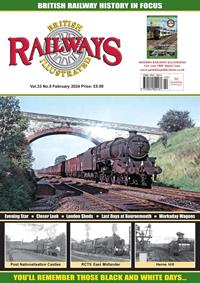|
|
Contents Listing - Articles & Features in this issue
THE GN MAIN LINE IN LONDON - By Peter Kay Steam on the GN George's Wife FROM KENT TO CORNWALL - Standard Tanks on the Southern Region - Part 3 - Western Section OPENING OUT THE HATTERSLEY TUNNELS FORTY YEARS ON - 1956 AND ALL THAT - By Philip Atkins, Librarian National Railway Museum Fourum OLD KING COAL - By 393 Squadron Competition Results A Reader Writes A Life of Steam Cover: 60123 H.A. IVATT north of Wood Green (Hertford Loop flyover is above the train) with a down Leeds/Bradford train, 18 August 1962.
Article Snippets
Welcome to British Railways Illustrated, Volume 5 No. 10. It is rather sobering to leam that the main line you grew up with, and regarded, with some proprietorial pride (in your short trousered days) as a bit of a cut above the rest, was in fact, 'one of the most fascinating surviving pieces of Victorian railway infrastructure.' And so it was - it fair bristled with venerable signals and the daily journey to and from 'town' was punctuated and enlivened by leaning, sagging signal boxes, their names learned by heart and each regarded as an old friend. In the first of several articles, Peter Kay begins to set down the story. Even as late as the 1970s, The Great Northern Main Line in London was still a wondrous thing, unrationalised and unmodernised. As the author states, 'This article and those that follow are dedicated to unravelling the past of the GN in London; not as the 'final word' but concentrating on the infrastructure, signalling and operating in BR days and explaining how it came to be as it was.' How it came to be as it was - that's the way to do it. From Kent to Cornwall makes its final curtain call, the third and last part describing the spread of the strangers throughout the west of the Southern Region. Their peregrinations (too good a word not to repeat from last issue) are perhaps best remembered on the Western Section: the little 2-,6-2Ts in particular, looked just right on many of the branches in Devon. Cornwall, Dorset and Hampshire. The 2-6-4Ts seemed less comfortable, maybe, but once again, as was the case on the Central Section (see Part Two) the end of steam in the west was played out often to the accompaniment of BR, rather than 'native' locos. On perhaps no other Region (to borrow again from last month) did,the Standards get such a hold and achieve such general acceptance. The tanks infiltrated every branch, every working, to permeate the Southern. Whatever the considerations today, the rights and wrongs, environmental, social and political, it is surely true that if every big engineering project in our railway past had been forced through the agonising process facing every development today, then the system would have been fatally hobbled. In the 1930s, partly as a stratagem against unemployment, vast projects were undertaken, widenings and so on which were simply presented to Parliament, passed and were then, well, done. In the 1920s it seems to have been even more straightforward. With billions of pounds of remedial work arrears outstanding on Railtrack (according to the national press) can we even conceive, today, of anything on the scale of the Hattersley Tunnels? Even this relatively obscure comer of the LNER. represented an enormous traffic - so much that the line it was cheerfully thought would soon require widening to four tracks. The Hattersley Tunnels represented the everyday bread and butter of the railway and for bread and butter, read - coal. Coal lay at the heart of railway operation and it must be said. it is a strangely neglected subject- We've all been a bit guilty of this and Old King Coal is brill's small attempt at some small restitution. Quite why the vast coal trade which so sustained our railways has received relatively scant attention is hard to divine - that it was so disparate and scattered is one reason and the places where it was concentrated - yards and collieries - were difficult to penetrate. Beyond idly counting the wagons as yet another 9F or WD clumped by, what attention did we pay them? 'Coal trucks' were there in thousands upon thousands. Who could dream that the time was not that far off when they would be an endangered species.....
Adverts and Links based on this content
Advertisement



